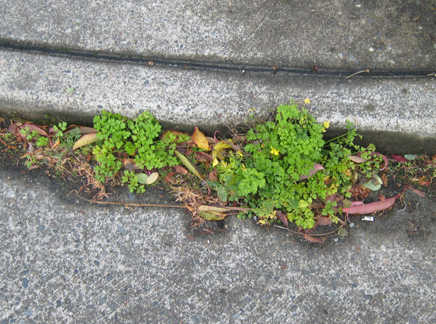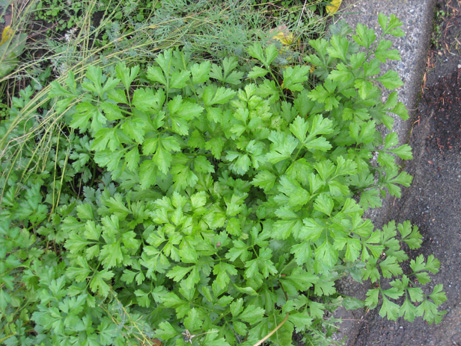| Parsley is extremely familiar. Writing an article about such a well known plant may be thought silly as to write about rainfall. In the Language of Flowers, Parsley signifies entertainment; feasting; festivity. Well, as usual, when you start investigating the matter, there is more to Parsley than merely its role as an overused garnish. |
| It is likely the number one garnish plant; the most commonly grown "herb" in home gardens; and now it has escaped from cultivation and can be found wild in about half of the United States --including here in Seattle. |
| Its original homeland is thought to be SE Europe and SW Asia. The ancient Greeks did not distinguish parsley and celery in that either could be called selinon. Parsley was the Petros Selinon, from petros (a rock or stone) and Selinon (celery or parsley), hence "rock celery" I guess because the other celery grows in mucky places, while the Parsley grows in better drained, rockier sites. So the ancient Latin name became Petroselinum, adopted as the scientific generic name in 1756. |
| It is interesting that such a common plant has so few common names in English. It is almost invariably called Parsley. Some other European names are: French Le Persil. German Petersilie. Dutch Perterselie. Italian Petroselino or Prezzemolo. Spanish Perejil or Perexil. Portuguese Selsa. |
| Some of its cousins include Celery, Lovage, Cilantro, Mitsuba, Chervil, and the groundcover ornamental Ground-elder/Bishop's weed. |
| Parsley is grown in three broad categories. The most common is called the crisped-, curly- or moss-leaf Parsley. This is frilly and wavy, and the leaves and plant size are relatively small. This group has been called var. crispum. |
| The next most common is called the plain- or flat- or Celery-leaf or Italian-Parsley. Its leaves are flat, and the plant is more robust, up to 3 feet tall. It also has more concentrated flavor. This group has been called var. latifolium or neapolitanum. |
| Least known and grown is the Hamburg-, Turnip-rooted or Soup Parsley, featuring a stout edible root like a plump little parsnip. This group has been called var. tuberosum. |
| In his 1998 book Cornucopia II, Stephen Facciola enumerates 19 leaf Parsley cultivars, 8 root ones. |
| Parsley is easy to grow. Though you must make some effort if you want lots of it year-round --as to supply a restaurant-- otherwise it is among the simplest of all garden plants. Just sow the seeds and be patient. They take weeks to germinate. Folklore says the seeds go to Hell (the Devil) and back several times before they sprout. Despite the commonly stated advice of rich moist soil, and sun, Parsley does not need as much. It can grow in unimproved ground, in alley cracks, in considerable shade. |
| I hasten to add that most of my experience with growing parsley or finding it wild is with the flat-leaf kind; the curly parsley is relatively weak and demanding. And the Turnip-rooted one, like all root crops to be eaten, needs a fertile, loose, ideal soil if it is to be plump, fast growing and choice eating. |
| Parsley in its first year is just a bunch of bright green leaves. In its second year it sends up a straight, branched flower-stem that will vary from about a foot to 3 feet in height. It is solid, ridged, and when young and tender is edible just like the leaves. So are the flowerbuds, flowers, and unripe green seeds. You can eat them raw or cooked. Favorite uses include the tabouleh (tabouli) salads, salsa verde, etc. |
| Parsley typically dies after going to seed. But sometimes, if you keep plucking at a plant, not letting it reseed, it lives more than two years. Depending on the cultivar, the growing conditions, and the weather, it can be eaten practically or wholly year-round. It is high in vitamin C and other healthy substances. But eating too much, as with rosemary and certain other spices, is toxic. In fact too much fresh parsley can cause an abortion. |
| In addition to its culinary role, parsley has been used in other ways. The oil has been put into perfumes for men. And, Julia Morton wrote in her 1976 book Herbs and Spices, the "herb oil and the seed oil are employed in commercial preparation of sauces, pickles, meats, bakery products, and soups." (p. 34) Roy Vickery's 1995 Oxford Dictionary of Plant-Lore says: "With the possible exception of Apple, Parsley is the focus of more superstitious beliefs than any other plant commonly grown in [English] gardens." It can variously be interpreted as signifying wifely dominance in a household; an ill omen, if transplanted; and (as stated above) the seeds are so slow to sprout that they visit the devil first. |
| In herbal medicine Parsley has played a relatively minor yet very interesting role. Most books on medicinal plants include it. In the same way that I am not giving recipes regarding its precise role in the kitchen, nor will I advise on healing uses. Suffice to mention Parsley has been used in things as diverse as gallstones; liver regeneration; to relieve the pain of dysmenorrhea; angina pain; and cystitis. |
| I end with two quotes from Gary Lockhart's unpublished books: "A curious experiment was done by having three nonsmoking men eat smoked salmon. The smoke contains mutagenic chemicals. The urine was used to water bacteria and the number of mutations was counted. The men who had eaten parsley had significantly lower numbers of mutations." (A Woman's Herbal, chapter 31 Birth Defects) |
| "The ancient Greeks planted parsley on graves, and parsley was a symbol of bad luck for this reason. Plutarch has an account in his Lives. The Corinthian General Timolean led an army for an attack on the Carthaginians. When they marched up a long hill, they bumped into mules loaded with parsley. The soldiers took this as an omen of death, and began to break ranks. They remembered the Greek proverb: He doesn't need anything, except parsley. |
Timoleon halted the troops and explained to them that at the Isthmean games the victors were crowned with parsley as an omen of triumph. Then he made a wreath of parsley and had his captains do the same. This changed the attitude of the troops and they won a great victory." (Herbal Scraps chapter 73)
Back |

Parsley wild in sidewalk crack photo by ALJ
|

flat-leaf Parsley close-up photo by ALJ
|

